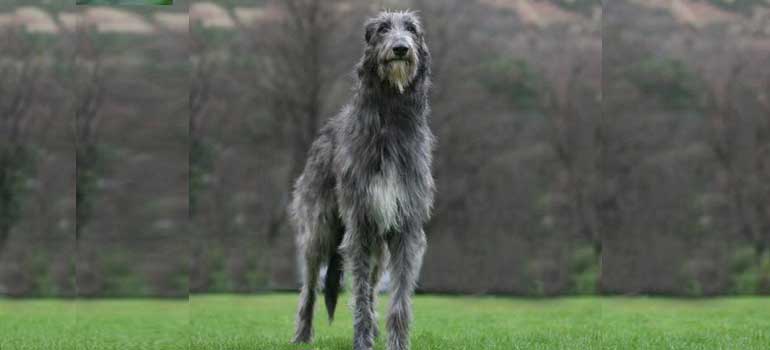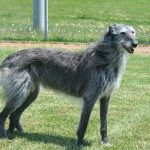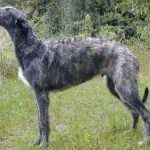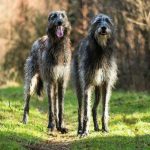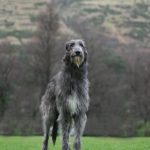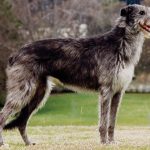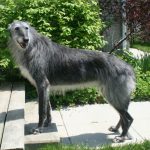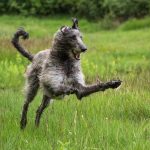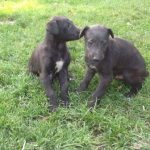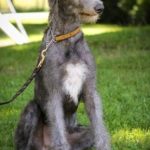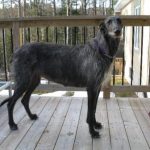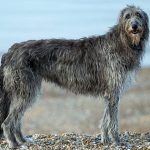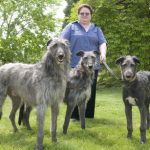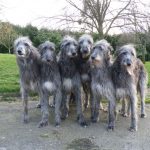The Scottish Deerhound is a large sized dog breed of hounds, from the UK, originally from Scotland, hence the name.
It is often referred to as the “Deerhounds” and it is a sighthound.
They were once bred to hunt the Red Deer by coursing, that is a game or hunting technique where dogs catch their prey by speed and sight, and not by scent. These game dogs have an athletic and well-muscled built.
Editor’s Recommendation: “Golden Pyrenees Dog Breed Information“
Appearance of the Scottish Deerhound
They are tall and generally slim with a long flat head which is broad in the middle, and a muzzle that tapers to a point and ends in a black or blue nose.
Its eyes are rimmed in black and are hazel or brown in color.
Its ears are glossy and dark and are set high and fold back and are half erect when the dog is alert.
It has a long tail that can be curved or straight and it almost touches the ground.
Pictures of Scottish Deerhound
Quick Information and Facts about Scottish Deerhound
| Characteristics | Details |
|---|---|
| Name | Scottish Deerhound |
| Other Names | Deerhound, Scotch Greyhound |
| Color | Blue, brindle, fawn, gray, black red, yellowish |
| Coat | Long or medium, short, wiry, harsh, thick, rough |
| Breed Type | PurebredPurebred |
| Breed Group | Hound |
| Size | Large |
| Hieght | Male: 30-32 inches Female: 28 inches (avg) |
| Weight | Male 85–110 lb (39–50 kg) Female 75–95 lb (34–43 kg) |
| Life Span/Life Expentancy | 8-9 Years |
| Temperament | Intelligent, adaptable, friendly, quiet, gentle, strong |
| Shedding | Moderate (Seasonal) |
| Hypoallergenic | No |
| Barking Level | Minimal-moderate (Barks when necessary) |
| Energy Level | Active |
| Good with Children | Yes ( Supervision is advised with younger kids) |
| Good with Other Dogs | Yes |
| Litter Size | 4-15 puppies |
| Country of Origin | Scotland |
| Competitive Registration/Qualification Information | AKC, KC, ANKC, AKC, CKC, NZKC, UKC, FCI |
History of Scottish Deerhound
Temperament & Personality
The Scottish Deerhound is a gentle, polite and well-mannered dog. They are very loyal and devoted and so mix well with children too giving them a great company.
They are quiet, dignified and docile and very friendly in nature. They love to be around people and hence they do not get along well in homes where they are left on their own.
The deerhounds rarely bark so they do not make good watchdogs or guard dogs owing to their friendly nature with strangers.
Scottish Deerhound Puppy
As a puppy, the Scottish Deerhound is active and more mischievous and playful.
Early Socialization and exposure to different people, sounds, and sights at a young age ensure that your Deerhound Puppy grows up to be a well-rounded pooch.
The Deerhound is a fairly active dog and so needs regular exercise to remain fit and healthy.
Despite its calm and quiet nature, this breed is less suitable for apartment dwellers.
Regular walks to nearby parks for an hour or so every day keeps them playful and happy.
Care: Exercise, Grooming and Health Issues
Exercise
This is a very active breed that needs to be taken out on a daily basis. They enjoy long walks and runs, making an excellent jogging companion.
Always keep in mind that they have an instinct to chase so do not let them off the lead in an unsafe area.
Deerhound puppies need plenty of off-leash exercise in a safely fenced area to develop their bones and joints properly.
While it’s interesting and breathtaking to see a Deerhound in action, it’s heartbreaking to see him injured in the chase or hurt other animals he is chasing.
So proper care and a watch is a must!
Grooming
Scottish Deerhounds are average shedders. They have a thick coat which is on an average 3-4 inches long, harsh and wiry.
Regular brushing the coat of the Deerhound with wire slicker brush will be great to stimulate the circulation and removal of dead hair and skin from the coat.
This will enhance the distribution of the natural skin oils and the shine on its skin. Remember to brush in the direction the hair is growing. To give the final makeover use a metal comb — known as a greyhound comb — to get rid of the tangles.
Bathe your deerhound when it gets messy to remove all dirt, dust, and unwanted odor and tidy him up.
Other grooming needs include trimming the nails regularly, dental care, and cleaning eyes and ears with soft cotton balls.
Since deerhounds have floppy ears it’s important to clean them twice a week to avoid ear infections.
Health Problems
Training
Though Deerhounds are gentle and docile indoors they are tough to train due to their lazy and laid-back attitude.
Training them will be moderately easy for experienced owners. They will gradually and slowly respond to the sessions at its own pace.
To make the training sessions interesting and playful you can try new techniques and tacts so that they don’t get bored easily.
Make sure you provide its basic obedience training early on, and should also start early socialization when you get it.
To keep them upbeat offer plenty of treats, rewards, and encouragement.
Feeding
What you feed your dog with is an individual choice, but working with your veterinarian/breeder, in the beginning, will be the best way to get an idea and determine the frequency of meals for a Deerhound Puppy or best adult diet to increase his longevity.
However, it’s recommended to feed this large breed with 3-4 cups of high-quality dry dog food daily divided into 2-3 meals.
Giant Scottish Deerhound Running Video
Interesting Facts
- It was a breed of the royal, and no one but those in the designation of an earl could buy the greyhounds.
- They are one of the fastest dogs, having a speed of 38 mph.
- This breed featured in two movies of the Harry Potter series namely “Harry Potter and the Order of the Phoenix” (2007) as well as “Harry Potter and the Prisoner of Azkaban.”

